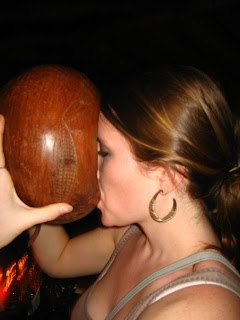
Whoever told me that South Africans eat nothing but meat and starch (cough, LonelyPlanet, cough) must have never visited the country. I’ve eaten a lot in just a few weeks, and while meat and starch play important and delicious roles, they’re far from the only thing offered.
That said, all bread I’ve tried is extremely hearty. Even the bread offered as a precursor to dinner at restaurants is brown and full of seeds. The one exception is steam bread, a traditional recipe with some beautiful name that I’ve forgotten, though I’m pretty sure it has clicks in it. The slices are very light, the interior moist and airy, while the thin crust provides a quite satisfying crunch. And to top it all off, there’s this fruity sweetness to it that I can’t place, but it’s unlike any bread I’ve ever tasted before.
We’ve had multiple braais, which is what the South Africans call their barbecues. They’re eerily reminiscent of American barbecues, serving meat with Italian salad, beer, and perhaps even beans. One afternoon, we got roasted lamb that fell apart after hours on the grill, all stacked in the corner of the braai, ready for scooping. I had way too much of this, and thanked the man behind the grill a zillion times. They’re very proud and competitive about their braais, so I figured it was the least I could do to show my appreciation.
Another braai served boerewors, a spicy sausage that was red inside, for some reason unknown to me (but I try not to question when things taste good.) The campus food is also stellar—we found a tiny Indian stand made of brightly painted wood, sort of giving off a circus vibe. The tiny woman behind it served up apple cinnamon, butternut squash, and spinach & feta samosas. Did I mention they were 60 cents each and the size of my fist? Did I also mention this stand is in the philosophy and politics building where all my classes are? Yeah.
They like to call their paninis “tramezzinis” here, tahini is referred to as sesame pulp, and sunflower seed oil is just sunflower fat. It’s very difficult to find skim milk or yogurt, I’ve only seen one McDonalds, and there are KFC’s everywhere.
Drinkwise, I’ve sampled the local Castle and Black Label beers (Black Label is the way to go, as if you can’t tell by the name). Amarula is their cream liquor from an African plant, but it’s pretty indistinguishable from Baileys. Instead of Smirnoff Ice with a variety of flavors, here they just offer Smirnoff Twist, a lemony bottle of 5.5% alcohol that could pass for Sprite if it really wanted to. I tried the locally-brewed sorghum beer, made from sorghum and served in a huge wooden bowl. To be quite honest, it tasted like beer-flavored yogurt that had been left out on the counter for a few days. But the experience of drinking it and passing the huge bowl around was a fun one.
And finally, I ordered my first frilly mixed drink in a restaurant my second night here—it had a fancy name that other Americans at my table knew, but I can’t recall. The umbrella spear sported some pineapple and lime slices and sat atop a mix of ginger beer, dark rum, and lime juice. At the risk of pulling a she-who-must-not-be-named, yummo.
I should also mention that, at a bar called Rafiki that played Sublime and the Beatles, I asked for a lime to accompany my tequila shot and was given another shot of lime flavored liquor. Noted.
GLOSSARY:
Boerewors—spicy sausage
Breyani—mix of rice and minced meat, sweetly spiced with yogurt sauce
Malva pudding—brandy-soaked sponge cake topped with vanilla cream
Geelrys—rice with raisins and spices
Blatjang—spicy fruit chutney
Smoorsnoek—flaked snoek with potato slices and tomato
Witblitz—strong spirit distilled from peaches
Sosaties—kebabs of meet, onion, and dried fruit basted in a curry sauce and grilled
Bobotie—minced beef baked with egg custard topping
Melktert—milk tart with cinnamon topping
Mealie papp—porridge/grits
Bunny chow—portable loaf of bread filled with curry, made during apartheid when blacks weren’t allowed in restaurants
STILL TO TRY:
mealie papp, bunny chow, ostrich, cape malay cooking, bobotie, melktert, sosaties
No comments:
Post a Comment